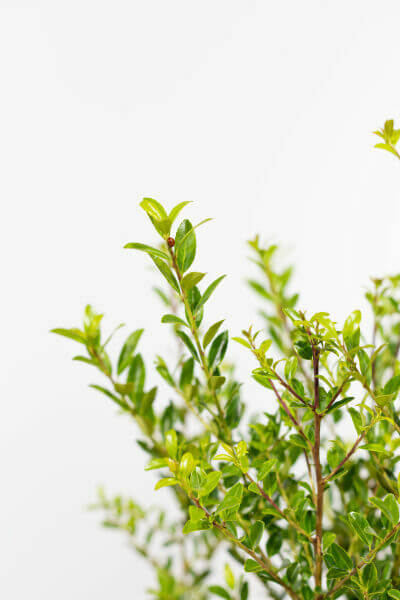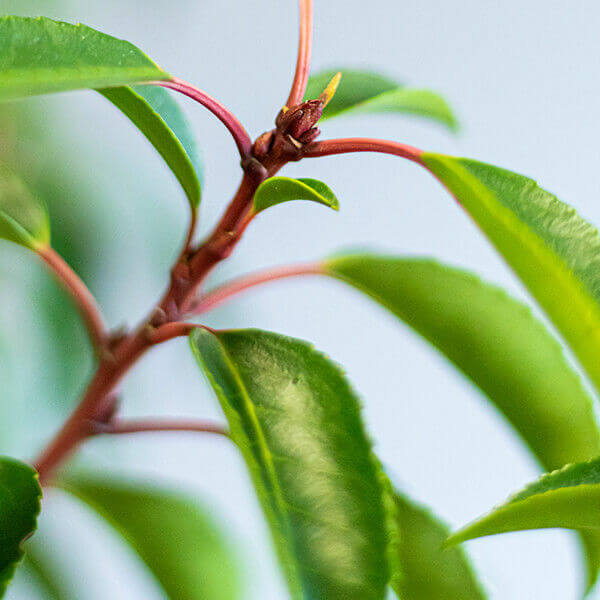Hedging Plants For Windbreaks
Enhance your garden's attraction with lavish hedge ranges such as Yew (Taxus), Thuja, Laurel, Photinia, and Bamboo, celebrated for their structural stability and environmental benefits.
Yew and Thuja provide evergreen protection and winter durability, while Laurel offers fast development and broad, fragrant leaves.
Photinia includes seasonal appeal with its lively red foliage, and Bamboo lends a low-maintenance, peaceful atmosphere.
These hedges improve air quality, minimize noise, and produce tranquil, personal spaces.
Appropriate planting, spacing, and upkeep ensure vigorous development and ecological harmony.
Check out how these lavish varieties can elevate your garden's appeal and wellness.
Key Takeaways
Transform Your Garden With Lush Hedge Ranges
- Select Yew for its dense, evergreen growth and unrivaled durability.
- Select Laurel for its fast growth and broad leaves, guaranteeing fast personal privacy.
- Pick Photinia for its dynamic seasonal foliage, which turns a striking dark red.
- Use Bamboo for a low-maintenance, winter-hardy hedge with visual appeal.
- Area plants 2-3 per meter and prune frequently for optimum growth and health.
Popular Hedge Plants
When transforming a garden with lush hedge varieties, it's important to think about popular hedge plants such as Yew, Thuja, Laurel, and Photinia due to their special attributes and advantages.
Yew (Taxus) is extremely respected for its durability and thick, green development, making it a prime option for sustaining landscapes.
Thuja is kept in mind for its evergreen foliage and robust winter season durability.
Photinia adds seasonal vibrancy with red leaves that darken in time, developing vibrant visual appeal.
Laurel uses quick development and fragrant, broad leaves, ideal for quick personal privacy.
In Addition, Bamboo is an exceptional option for atmosphere, providing a low-maintenance, winter-hardy choice that enhances the garden's aesthetic with its classy, swaying walking sticks.
These selections cater to a variety of horticultural requirements and choices.
Benefits of Garden Hedges
Garden hedges offer a multitude of advantages, making them a valuable addition to any landscape. These natural barriers are affordable to implement and supply substantial wind security, enhancing air blood circulation and adding to noise decrease. The dense foliage of hedges like Thuja and Beech ensures personal privacy by obstructing visibility, developing a serene and remote environment.
Hedges likewise play an essential function in microclimate policy, supplying a stable environment that fosters plant development and minimizes temperature level changes. Their intricate leaf structures filter contaminants, improving air quality and adding to a healthier garden environment.
Moreover, hedges master sound decrease, absorbing and deflecting acoustic waves to lower ambient sound levels. This dual performance of providing both visual and acoustic personal privacy enhances the general tranquility and aesthetic appeal of any garden.
Planting and Upkeep Tips
For a successful hedge, careful preparation of the planting area is essential. Make sure the soil has proper pH and drain to support strong root development.
Area the plants appropriately for the selected types. Water the hedge frequently throughout its preliminary development phase, adjusting as required with seasonal modifications.
Implement a methodical bug control and disease prevention technique, utilizing organic or chemical treatments when needed. Frequently inspect for aphids, mites, and fungal infections.
Apply mulch to keep wetness and suppress weeds. Seasonal pruning promotes dense growth and air blood circulation, essential for plant health.
Following these guidelines will help you cultivate a dynamic, well-maintained hedge that enhances the charm of your garden.
Spacing and Trimming Standards
Spacing and Trimming Guidelines
Proper spacing and trimming are essential for cultivating healthy, visually appealing hedges. Sufficient spacing guarantees each plant gets adequate nutrients, light, and air flow.
Follow these standards for optimum hedge upkeep:
- Spacing: Position hedge plants 2-3 plants per meter to motivate robust development.
- Pruning Methods: Regular pruning is important for preserving preferred hedge height and shape. Trim new growth in summer and cut down older wood throughout winter season.
- Seasonal Care: Change trimming methods and schedules according to seasonal requirements to ensure plant health.
- Hedge Height: Regularly display and trim to maintain the wanted hedge height and attain consistent aesthetic appeals.
Adhering to these actions will guarantee your hedge prospers, improving both the appeal and functionality of your garden.
Choosing the Right Hedge
Picking the Right Hedge
Choosing the Article source suitable hedge involves examining elements such as mature height, foliage density, and ecological durability. Successful hedge plant choice requires understanding each types' development characteristics and site-specific adaptability.
For instance, Yew (Taxus) offers exceptional longevity and dense development, while Thuja is notable for its winter season durability. In addition, considering upkeep requirements is important; fast-growing species like Laurel or Privet need regular cutting, whereas low-maintenance options like Bamboo or Ivy may be preferable for those looking for minimal upkeep.
Ecological elements such as soil type, light schedule, and moisture conditions need to also direct the selection process. This mindful approach guarantees the chosen hedges will flourish, supplying both aesthetic and practical advantages to the garden landscape.
Shipment and Planting Guidance
To guarantee your hedge plants grow, they ought to be provided by specialized carriers and planted promptly upon arrival.
Follow these vital actions for successful planting:
- Soil Preparation: Enrich the soil with raw material to enhance drain and nutrient content.
- Planting Depth: Produce a trench two times the width and equivalent to the depth of the root ball.
- Watering Strategies: Water thoroughly after planting, keeping the soil consistently damp however not filled.
- Mulching: Use a layer of mulch to maintain moisture and suppress weeds.
Client Support and Service
Offered the important function of prompt assistance in horticultural pursuits, our customer support group is readily available 6 days a week through telephone, e-mail, and social media to offer expert recommendations and quickly resolve any issues. Their devotion to fast action times ensures customer satisfaction by resolving queries related to plant health, optimal planting methods, and maintenance schedules.

Availability
Within 24 hours
This extensive support group, strengthened by an excellent 9.3/ 10 consumer rating, highlights our commitment to enhancing the gardening experience for each client.
Often Asked Concerns
The Length Of Time Does It Consider Hedge Plants to Develop?
Hedge plants usually need one to 3 years to end up being totally developed, with the specific period differing by types and growing conditions.
Efficient care throughout this vital period is important for robust growth. Consistent watering, vigilant weed control, and appropriate fertilizer application are pivotal in promoting strong root development.
For instance, fast-growing types like Laurel might establish quicker, while slower-growing varieties such as Yew might take longer. Thorough upkeep speeds up the establishment process, leading to healthy and thick hedges.
What Are the Best Hedge Plants for Privacy?
The question of the finest hedge plants for personal privacy involves evaluating evergreen and deciduous options.
Evergreen hedges like Thuja, Laurel, and Cypress supply year-round protection, guaranteeing continuous personal privacy.
On the other hand, deciduous hedges such as Beech provide seasonal privacy, shedding leaves in cooler months.
Key maintenance pointers for personal privacy hedges include regular cutting, fertilizing in spring, and correct spacing-- generally 2 to 3 plants per meter.
Additionally, constant watering and persistent weed removal are vital for promoting healthy, dense growth.
Can Hedge Plants Draw In Wildlife to My Garden?
Yes, hedge plants can attract wildlife to your garden by supplying important advantages like shelter, food, and nesting websites, thus enhancing regional biodiversity. Yew, holly, and laurel are excellent for drawing in birds, while ivy supports a variety of bugs.
Nevertheless, it is necessary to keep in mind that there are some disadvantages, such as increased upkeep to manage insects and regular maintenance. Thoroughly choosing and keeping hedge varieties can assist stabilize these drawbacks and benefits, eventually fostering a dynamic and sustainable ecosystem in your garden.
Exist Any Blooming Hedge Plants Available?
Yes, there are flowering hedge plants available that can improve the appeal of your garden.
For instance, Elaeagnus, also known as Olive Willow, produces aromatic white flowers in the fall, including a touch of elegance.
Photinia, another popular choice, showcases dynamic red leaves that grow into a rich green, creating a dynamic visual result throughout the seasons.
To make sure these plants thrive, it's important to practice appropriate pruning strategies and seasonal upkeep, such as trimming new growth in the summertime and cutting down in the winter season.
These procedures will assist maintain the health and aesthetic appeal of your flowering hedges.
How Do I Prevent Bugs in My Hedge Plants?
To prevent pests in hedge plants, employ natural pest control techniques and preserve appropriate hedge care. Present useful pests like ladybugs, which victimize damaging bugs, to develop a well balanced ecosystem.
Regularly inspect your hedges for signs of infestation and promptly remove any afflicted parts to prevent the spread. Ensure the health of your hedges by using well balanced fertilizers and supplying sufficient water.
Use mulching to keep soil moisture and proper spacing to reduce plant tension and promote robust development. These practices collectively help in minimizing pest concerns and keeping a healthy hedge.
Conclusion
In essence, selecting the best hedge varieties such as Yew, Thuja, and Laurel can change any garden into a relaxing sanctuary. These plants provide year-round greenery, enhance visual appeal, and deal practical benefits like sound reduction and wind protection.
Correct planting strategies, accurate spacing, consistent watering, and seasonal cutting are important for optimal development.
Trusted delivery services and expert consumer support ensure a smooth experience from purchase to planting, making it simpler than ever to raise your outdoor area.
Garden hedges provide a multitude of advantages, making them a valuable addition to any landscape. These natural barriers are cost-efficient to execute and provide substantial wind protection, improving air circulation and contributing to sound reduction. The thick foliage of hedges like Thuja and Beech ensures personal privacy by obstructing exposure, creating a peaceful and secluded environment.

Pruning Methods: Regular pruning is necessary for keeping preferred hedge height and shape. Trim brand-new growth in summer and cut back older wood throughout winter season.
Comments on “Best Hedging Plants For Urban Gardens”